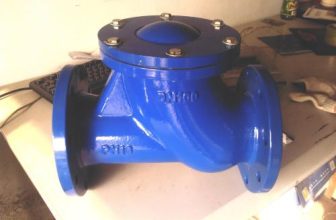
Ball Valve Manufacturers
LUCKY6S manufactures high-quality ball valves that may be customized to the client’s specifications. Ball valves are a type of shut-off valve that can be used to control the flow of gas or liquid. A rotary ball with a bore can be used to do this. The gas or liquid is blocked or permitted to pass through by turning the ball 90 degrees. Even when not in use for a long time, they are renowned to provide reliable sealing. They have a longer lifespan as well. Furthermore, they are more resistant to impurities than conventional valves, making them a more preferred option.
For all your gas and liquid handling applications, rely on the LUCKY6S ball valves manufacturer to produce only the best ball valves!
Read More
Ball valves are fast-acting quarter-turn valves that transfer media flow through a system using a rotating ball. They are gaining popularity in a variety of industries due to its strong shut-off feature. They’re used in the oil and gas sector, petrochemicals, power generation, pipelines, and just about any other application that requires fluid shut-off. Ball valves come in a variety of styles and add-ons, making it difficult to keep track of them all. Additionally, while most ball valves are utilized for on/off purposes, other kinds have found usage in throttling applications. All of these factors make deciding which ball valve type is ideal for your application difficult. Because ball valves are so complicated, we’ve broken down all the elements to help you understand them better. This article will assist you in determining which ball valve will provide you with the best outcomes.
How to Select the Best Ball Valves for Your Needs ?
It is critical to understand the specific requirements of your application before purchasing a ball valve. This is necessary for the ball valve to perform effectively, safely, and for it to last a long time. Here are some of the most significant elements to consider when choosing a valve that will last for many years.
When you choose ball valves, there are a few things to keep in mind.
The Flow Media
The process media’s features have a big impact on the whole system, including how the ball valve works. You must determine them in order to ensure that you utilize the correct ball valve for your application. You should consider the following factors, but they are not exhaustive:
The media’s flow qualities, such as viscosity and materials that pass through the system; if the process fluid is abrasive or corrosive;
The chemical reaction between the media and the valve and other system components is a possibility.
The Purpose and Function
Depending on the application, ball valves may be required to perform additional duties. Ball valves come in a variety of sizes and shapes, making them suitable for a wide range of applications.
Should the valve, for example, entirely stop and start the flow or is it also used for throttling? Is it necessary to control or release system pressure? What is the maximum amount of leakage that the system can tolerate? How precisely should the flow be controlled by the valve? Identifying the functions of your ball valve will help you choose the proper one for delivering safely and effectively.
The Temperatures at Work
Ball valves shut-off feature is also utilized to handle hot and cold liquids. It’s also critical to determine the temperature of the process media since this will assist you to select the right ball valve brand. Stainless steel, carbon steel, PTFE, PVC, and other materials are utilized in the construction of industrial valves. Each one is designed to work in a specified temperature range.
The Pressure at Work
Ball valves include shut-off characteristics that are designed to manage a variety of liquid pressures. It is critical to know the pressure range through which the ball valve will operate. This enables you to select the proper size and maximum pressure capacity for the job at hand.
Cleaning and Maintenance Requirements
Maintenance and cleaning requirements are also critical because they affect the overall system’s performance. Is it simple to maintain the valves? How often do the valves need to be serviced? These inquiries will assist you in determining whether the valves are appropriate and practical for the whole application.
Collaboration with Other System
When selecting a ball valve, keep in mind how well it will integrate with the other of the system’s components. Larger valves, for example, can handle higher pressures but are inconvenient to use in tight spaces.
Other Application Specific Conditions
Other special parameters are related to the nature of the operation and the industry’s required standards. For example, your application may have stringent cleanliness restrictions, which could influence the ball valve’s performance. The following are some of the other possibilities:
Collaboration with Other System Components
Before buying a ball valve, it is essential that you understand the specific requirements of your application. This is for the ball valve to function efficiently, safely, and have a long service life. To guide you, here are the important factors that will help you select the right valve that will serve you for many years.
Valve Shutoff
This is a stopper that can only be rotated 90 degrees. It is commonly used to correctly regulate flow in industrial applications such as petrochemical and chemical, plumbing services, human workstations, and other critical machinery. It also serves as a safety element by ensuring that the flow is entirely stopped.
Swing Check
A swing check allows a ball valve to perform the same functions as a check valve. This prevents media flow from returning to the system.
Anti-static Device
An anti-static device prevents a buildup of static electricity due to valve friction. A static buildup is a fire hazard, particularly if the media flow is flammable.
Fire-safe Design
A backup metal seat for the ball valve is provided by a fire-safe design. This is especially important when the system temperature rises to dangerous levels, causing damage to the soft seat. The backup seat will offer support if the soft seat softens or melts, preventing leaking and an unintentional fire.
Standard Face-to-face Dimensions
These specifications meet ASME requirements, making it simple to change and replace the valve with valves from other manufacturers.
Indicators of Position
The direction of the flow is indicated by a position indicator. It is widely used in multi-port ball valves and sits on top of the ball. It’s also used to make sure a ball valve is properly aligned. To minimize damages and significant injuries in industrial processes, it is critical to be fully informed of valve operations.
Blow-out Proof Stem
A blow-out-proof stem contributes to safe and smooth industrial operations. It is an excellent addition that ensures the valve stem will not fly or blow out when the ball valve is receiving too much pressure.

Oil and Gas Industries
In the oil and gas industries, the pipelines used mostly need to be manually operated and should withstand critical service conditions. These will include extremely high pressures and temperatures or severely low pressures and cryogenic temperatures. These industries also include applications with high corrosion and erosion to which the ball valves must endure.

Water and Wastewater Applications
Ball valves used in water and wastewater applications need to conform to a range of requirements. The materials of ball valves used in these operations should be able to endure the chemical substances present in the process flow. Most of these applications may involve water that contains solids and other types of materials that could lead to buildup. The valves used must be able to handle material buildups and clogging to avoid disrupting the entire system.

Pharmaceutical and chemical industries
Ball valves used in the pharmaceutical and chemical industries should adhere to strict safety standards depending on the process media. For example, the materials of the valves must be non-reactive with any chemicals they will come in contact with. Also, in most applications, the materials should have excellent resistance to corrosion and
abrasion. Some applications also involve extreme temperatures and pressures. The ball valves used in these industries are required to provide accurate flow control and avoid any chances of leakage of dangerous materials.

Food and Beverage Industries
Food and beverage industries require strict sanitary guidelines to which ball valves must comply. Some of these require the valves to have
smooth surfaces without any pores and crevices in which materials and bacteria could build up. The materials the valves are made should not affect, like contaminate or degrade, the product.

Pipeline industries
In most applications, ball valves used in large pipelines need to be”piggable.” This means that the valve bore should have a diameter that fits a pipeline pig to perform inspections, cleaning, and maintenance tasks. In most services, full bore ball valves are used, which have a similar size to the pipelines when in an open position.
Ball Valve Types classified by Material
Ball valves might serve the same function of providing a positive shut-off. However, they are not all the same and each is specifically designed to function with certain materials, pressure rating, temperature, etc. To help you understand which ball valve you need, here is a breakdown of the different ball valve types.
Stainless Steel Ball Valves
A stainless steel ball valve is a type of valve that is noted for its long life and corrosion resistance, making it ideal for a wide range of applications. Extremely high temperatures and pressures, extremely low pressures, and cryogenic applications are all examples. It can also be used to deal with chemicals that may corrode other substances in the system. A stainless steel ball valve can deal with varied qualities of liquid and gas flow and ensure a tight seal with no leakage due to its strength and great durability. It’s commonly utilized in the oil and gas industry, as well as the petrochemical and chemical sectors, as well as power plants. A stainless steel ball valve is the most cost-effective and reliable option for industrial applications due to its various characteristics. It is capable of handling the most demanding applications while also requiring less upkeep.
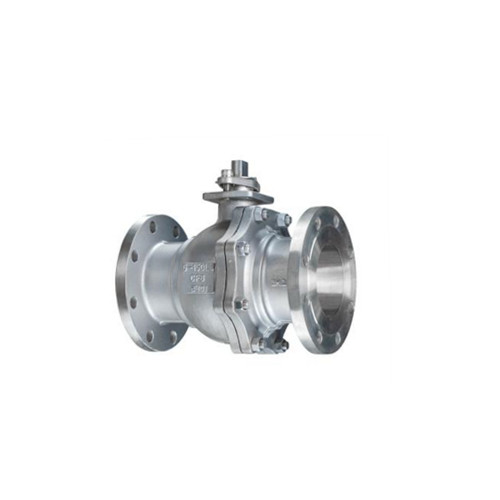

Forged Steel Ball Valves
A forged steel ball valve is composed of forged steel, which is an iron and carbon alloy that has been squeezed under high pressure. Ball valves made of this material are robust and strong, making them perfect for a variety of industrial applications. This ball valve is designed to provide positive shut-off in harsh operating environments. Pipelines, processing plants, and other important industrial applications, both critical and non-critical, fall under this category. The fact that a forged steel ball valve has zero to minimal flow resistance is a significant advantage. Because the valve seat is commonly constructed of PTFE elastomer, it ensures reliable sealing even at high temperatures and pressures.
Cast Steel Ball Valves
A cast steel ball valve is a valve that is composed of many types of steel, giving it exceptional strength and shock resistance. A cast steel valve is created by converting liquid steel into metal, which is then molded and manufactured into valve components. A cast steel ball valve can withstand a wide variety of pressures and temperatures due to its strength, corrosion resistance, and temperature tolerance. It’s widely employed in significant industrial applications like petrochemical facilities, refineries, and oil pipelines. Cast steel’s design versatility allows for the creation of valves of various sizes and shapes, which is a considerable advantage. As a result, it’s great for bespoke ball valves because it’s simple to mold and create to match individual needs, particularly for unusual patterns and intricate shapes.
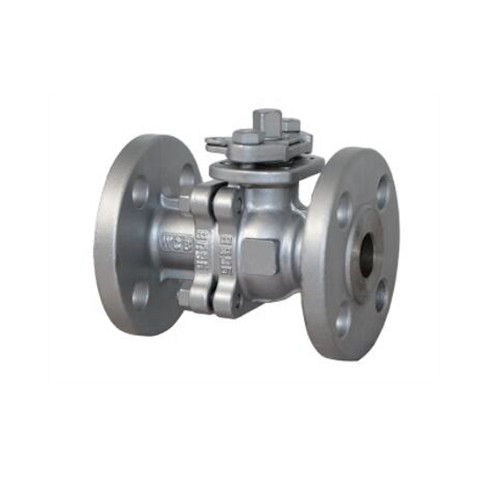

Cast Iron Ball Valves
Cast iron is a firm substance that should not be bent, which is what a cast iron ball valve is comprised of. This substance is composed of 96–98 percent iron, 2–4% carbon, and a small amount of silicone. This type of ball valve is noted for its ability to withstand high vibrations. Cast iron ball valves are utilized in harsh industrial applications with temperatures up to 2,100°F (1,150°C) due to their great temperature resistance. It’s also tough, although the amount of pressure it can handle depends on its size, pressure class, and end connections. It’s frequently utilized in water and wastewater treatment, as well as oil and gas and chemical applications. Cast iron ball valves have several advantages, including good corrosion resistance and longevity. Because this ball valve will be exposed to a variety of liquids, cast iron is ideal for preventing the valve from responding to extended contact with varied flow media.
Design Types of Ball Valves
Trunnion Mounted Ball Valves
A trunnion-mounted ball valve is one that has an extra anchoring device at the top and bottom of the valve to keep it in place. There is a significant reduction in friction and alleviation from excess pressure with this feature. This ensures the system’s safety and stability, as well as a longer service life for the trunnion ball valve. A trunnion ball valve’s bubble-tight sealing feature makes it ideal for a variety of industrial applications. Gas processing factories, LNG plants, petrochemical and chemical businesses, and hydrocarbon processing will all be included. The main benefit of employing a trunnion-mounted ball valve is that it ensures a safe and steady operation. It ensures positive sealing and eliminates the possibility of leakage, extending the life of the ball valve.
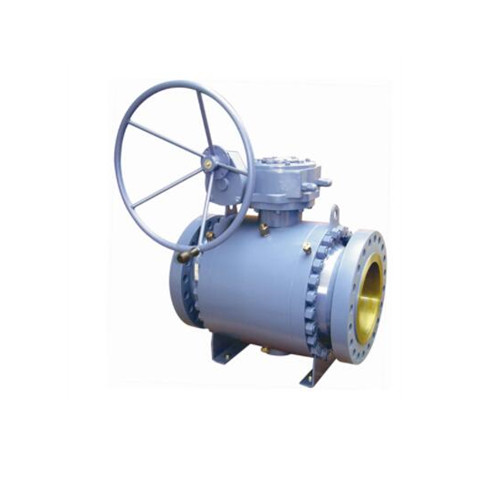
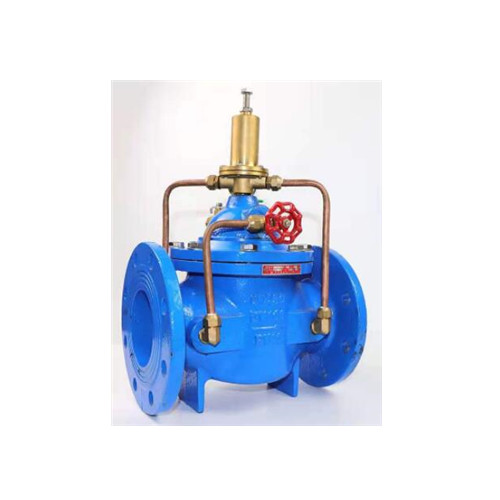
Floating Ball Valves
A floating ball valve is one that lacks the additional anchoring device present in trunnion ball valves. Instead than holding the ball in place, this lets it to “float.” Depending on the flow pressure in the pipeline, the ball travels down somewhat until it comes into touch with the opening. This forms a tight seal, preventing the flow of media from going through. Smaller diameters make this type of ball valve ideal for low-pressure applications. Oil and gas, food and beverage, petrochemical, and hydrocarbon sectors all use it.Because the pressure drives the ball against the downstream seat, a floating ball valve offers an extremely tight and forceful shut-off. This ensures that both the operator and the entire system work in a safe and efficient manner.
Double Block and Bleed Ball Valves
In one manifold or unit, a double block and bleed (DBB) ball valve has three valves: two isolation valves and one vent valve. It saves time during installation, cleaning, and maintenance because it performs the duties of three distinct valves. In essential applications where equipment maintenance, repair, or replacement does not disturb the entire system, a DBB ball valve is perfect. Oil and gas operations, chemical applications, and industrial processing units all employ it. A double block and bleed ball valve is important because it protects the integrity of the process medium by depressurizing the area that needs to be worked on. It prevents contamination by providing a tight shut-off that ensures the rest of the system runs safely and smoothly.

Ball Valve Types classified by Bore Size

Ball Valves with Full Bore and Full Port
A full port ball valve allows for unfettered flow and is perfect for applications that demand both free flow and positive shut-off. It has a big ball with a hole that is the same diameter as the pipeline, which reduces friction loss. It’s also known as a full bore ball valve, and it’s commonly employed in applications that need minimal flow resistance. It’s also employed in mixed solids and liquids media flows, where flow constraints might segregate constituents, causing clogging and accumulation. A full bore ball valve has a modest pressure drop and keeps the flow rate constant. This aids in maintaining the ball valve’s integrity so that it can continue to function efficiently for a long period.
Reduced Bore Ball Valves
Reduced Bore Ball Valves It has a straight flow path on the inside, where the ball valve becomes more constricted. Reduced bore valves are appropriate for applications where a small rise in pressure does not affect the entire process. It’s also used when the valve size and cost are critical considerations. The compact size and low cost of a decreased bore are its key advantages. When pressure loss isn’t an issue, a reduced bore valve is frequently utilized because it performs the same function as a full bore valve.

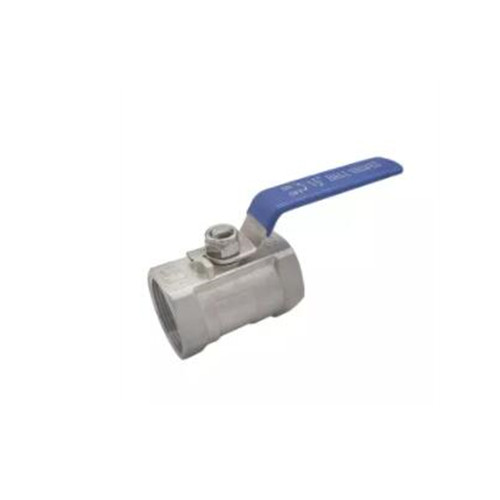
One-piece reduced bore ball valve
V-notch / V-port Ball Valves
A v-notch ball valve has a “v”-shaped seat or a “v”-haped ball that meets the piping requirements. This enables for a more controlled opening and closing of the hole or cavity. Because the flow velocity is adjusted based on the application, this ball valve is also known as a control valve. A v-port ball valve is used to open/close or control media flow in a variety of industrial applications. Food and beverage processing, water treatment, bleach chemicals, waste processing, agricultural uses, and petrochemicals are among the industries that may be affected. The sturdy structure of a v-port ball valve allows it to manage higher media flow velocities. It effectively controls flow rate and is free of cavitation, corrosion, vibration, and noise.
Ball Valve Types classified by Number of Ports
Two-port / Two-way Ball Valves
The most common type of ball valve is a two-way ball valve, which shuts off pressure flow in both directions. The inlet and output ports are the two ports or openings on the device. In a two-way ball valve, the ball has a single straight hole through which gas or liquid travels. Almost every business that requires excellent gaseous and fluid control uses a two-way ball valve. It can be utilized in simple on/off applications as well as complicated flow controls. This sort of ball valve has a simple design, simple operation, and efficient functionality, making it safe, dependable, and successful in practically any application.


Three-port / Three-way Ball Valves
A three-way ball valve is a multi-port valve with three ports: one inlet port and two exit ports. It is a better alternative to a two-way ball valve for sophisticated flow control.
It is commonly used in process applications in the oil and gas sectors, as well as power generation plants, due to its reliable sealing and compact construction. It’s also employed in various industrial applications where pressure flow needs to be diverted.
A three-way ball valve’s structure allows it to be cleaned, repaired, or maintained in-line, ensuring that system operation is not disrupted. It’s also simple to use and has low torque thanks to the stem’s unique shape. Its 90-degree twisting mechanism allows the ball valve to open and close entirely rapidly.
Ball Valve Types classified by Assembly
One-piece Ball Valves
A one-piece ball valve has a solid cast body that is placed as a single unit, with the ball and seal held in place by a retainer. During maintenance or repair, this assembly type cannot be detached. Its single-unit design, on the other hand, promotes reliable tight sealing and decreases the likelihood of the valve needing to be repaired. This type of assembly is commonly found in ball valves that need to deliver positive shut-off at a low cost. A one-piece ball valve is often used in light-duty applications where the environment isn’t crucial. A one-piece ball valve’s key benefit is its low cost and robustness. This ball valve is a great choice when the application isn’t too demanding and the valve doesn’t have to work too hard.


Two-piece Ball Valves
A two-piece ball valve has a floating ball and a body that consists of two pieces that are joined together with bolts and flanges. The two-piece design has more variations when it comes to sizes and connection types compared to one-piece designs. It’s the most commonly used assembly for industrial ball valves.
It is widely used in low-pressure and low-temperature applications to maintain positive sealing. It is used in many industries, including the oil and gas industries, hydrocarbon processing, water and wastewater treatment plants, chemical applications, and more.
A significant advantage of a two-piece ball valve is It provides easier assembly and operation wherein the procedure, such as maintenance, can be performed in-line.
Three-piece Ball Valves
Three parts make up a three-piece ball valve: two end caps and one body, with the end caps usually welded or threaded to the pipe. This assembly type is more effective than the one-piece or two-piece design when significant demands are placed on the valve.
A three-piece ball valve is ideal for high-pressure, high-temperature, and high-flow applications. It’s also employed when a project has unique requirements, like as cleanliness, cryogenic applications, or piggable services.
A three-piece design offers easy and quick access for valve maintenance without shutting down the process line, which is a significant benefit. The main body area can be readily pulled out without removing the end caps during the surgery. This allows for easy disassembly, reassembly, and servicing without the need for large system cuts.

Top-entry Ball Valves
A top-entry ball valve is made up of a bonnet and a body with a ball attached at the top. It is commonly equipped with a fire-safe design, an anti-static device, and a double block and bleed feature to perform under critical service situations. It’s frequently utilized in high-pressure applications that require minimal disassembly for in-line maintenance. Oil & gas, water services, chemical industries, and other businesses that demand reliable sealing are among them. A top-entry ball valve provides a positive shut-off with no danger of leakage due to its longevity and strong endurance under severe conditions. The top-entry design enables for simple and convenient in-line inspection, maintenance, and repair, enhancing the entire system’s safety and efficiency.
Side-entry Ball Valves
A side-entry ball valve often has a two-piece or three-piece body, with the valve’s ball located on the side. It’s composed of tough materials like stainless steel, carbon steel, or cast iron, so it can withstand the rigors of various applications. A side-entry ball valve is well-suited for a number of industrial applications due to its robust design. Extremely high pressures and temperatures, as well as extremely low pressures and cryogenic applications, will be among them. A side-entry ball valve’s key advantage is that it provides a safe and reliable working environment. This ball valve can offer a positive shut-off even in severe situations. It may include a double block and bleed feature to ensure that system functioning is not disrupted during equipment replacement, repair, or maintenance.

Ball Valve Types classified by Valve End Connection

Flange ball valve
End connections on a flanged ball valve are in the shape of flanges, which are joined by nuts and bolts. Regardless of valve size or pressure level, flanged connections are the most common technique of connecting valves. Gas, petroleum, water, and transportation services all require flanged connections. It’s also employed in hazardous media applications like the oil and gas industry, power generating, and the petrochemical and chemical industries. Low-pressure drop, rapid and easy turning operation, and positive sealing are the main advantages of employing a flanged end ball valve. All of these factors contribute to the system’s integrity.
Welded Ball Valves
A welded ball valve is one that is directly welded to the pipe. The welding method has a leak-proof feature that eliminates the possibility of leakage. Carbonized Teflon is commonly used for the seal ring and spring, allowing the ball valve to adjust to changes in temperature and pressure. This form of connection is often employed in high-pressure and high-temperature pipeline systems, where positive leak shutdown is important. It’s also utilized in the food and beverage and cosmetic industries to achieve specific sanitary standards. A welded connection creates a compact enclosure that increases strength without sacrificing weight. Because the ball valve and the pipe are made of similar materials, there is a low risk of deformation and unequal stress as a result of accidents or natural catastrophes.

There are two types of welded connections:
Socket WeldThe socket-shaped welded end of the ball valve is where the pipe is placed and welded into the ball valve. This connection method is mostly utilized for small valves under two inches in diameter.
Butt WeldTo make a connection, the pipe and valve ends are connected together and then welded together. For jointing, both butt edges are sloped. This connection can be used with any valve size.
Threaded Ball Valves
A threaded ball valve is one that is attached to the pipeline by pipe threads. This connection method is mostly utilized for small valves with a pressure level of 1 MPa or lower that are less than two inches in diameter. Despite its ease of installation, a threaded connection must meet certain standards in order to be successful. The pipe and valve threads, for example, should be made to the same specification to ensure a correct connection. On a white background, a ball valve with external and internal threads. End connections for thread valves are appropriate for low-pressure pipe systems and plumbing applications, such as water and wastewater. A threaded connection has a significant advantage over other connection types in that it does not require small elements such as nuts and bolts to attach. As a result, the threaded ball valve is both cost-effective and simple to install. Furthermore, a threaded ball valve’s direct and compact connection to a pipeline ensures that leakage is minimized.

There are two types of threading – male and female threads, and parallel and tapered threads:
Male / Female Threads
The gender of pipe threads can be determined by finding the threads. Male threads are found on the exterior of the hex nut, whereas female threads are found on the inside.
Parallel / Tapered Threads
Parallel threads have the same diameter at both ends, ensuring that they remain straight all the way down. Tapered threads, on the other hand, have a larger diameter on the male end and a smaller diameter on the female end.
Ball Valve Types Classified by Seat Type
Metal Seated Ball Valve
The seat of a metal-seated ball valve, such as Monel or 316 stainless steel, is constructed of metal. It’s most commonly employed in applications that need harsh conditions. High pressures and temperatures, low pressures and temperatures, and cryogenic conditions are all possibilities. It’s also good for anti-corrosion and anti-erosive applications. It’s typically found in the oil and gas industry, as well as power plants and refineries. The use of a metal-seated ball valve allows it to withstand temperatures of up to 1,000°F as well as severe service conditions. Hydraulic shock, intense flashing, and abrasive process media are also no match for it. A metal-seated ball valve is meant to improve the ball valve’s efficiency, safety, and service life.

Soft-seated Ball Valves
The seat of a soft-seated ball valve is commonly composed of thermoplastic materials like PTFE (polytetrafluoroethylene) or NBR (nitrile butadiene rubber) (nitrite butadiene rubber). With its quick-acting 90-degree rotation and low turning torque, it guarantees positive sealing. A soft-seated ball valve is ideal for applications that require chemical compatibility as well as positive sealing. Solvents, gas, water, acids, methane, oxygen, ethylene, and other media are all compatible with it. The chemical features of the media flow have no effect on the soft seat’s qualities. Soft-seated ball valves provide several advantages, including a simple and lightweight design, simple and convenient operation, and a low cost.
Ball Valve Types Classified by Service Conditions
High-pressure Ball Valves
To withstand high-pressure applications, a high-pressure ball valve is designed for greater durability, safety, and reliability. It is constructed of durable materials including stainless steel and carbon steel. Accessories are included with a high-pressure ball valve to improve its efficiency and reliability. These will have features such as an anti-static mechanism, a fire-safe design, and a longer stem, among others. It’s normally operated by hand for a more exact shut-off, but actuators can be added if automation is desired. It’s commonly employed in environments with high pressures and temperatures, as well as corrosive and abrasive media. Oil refineries, hydrocarbon processing, chlorine manufacture, cosmetic businesses, power plants, and other facilities will be among them. Because a high-pressure ball valve is extremely durable and can withstand a wide range of media flow qualities, it can ensure good sealing with zero leaks. It’s a tried-and-true method of ensuring that all system functions go smoothly. It ensures that the entire application runs in a safe, secure, and efficient manner.
High-temperature Ball Valves
A high-temperature ball valve is designed to withstand the rigors of a wide range of high-temperature and extremely abrasive applications. It’s made to let the ball to expand without causing damage, even at extreme temperatures. For further longevity, the valve seat sealing ring is constructed of diverse metal sheets on both sides. A high-temperature ball valve is employed in practically every industry because of its outstanding temperature tolerance. It’s ideal for slurries and media-containing materials in petrochemical, petroleum, wastewater, and other related services. Soft and metal sealing characteristics are combined in a high-temperature ball valve. This means that the ball valve can regulate or control media flow regardless of whether the temperature is relatively low or excessively high.
Cryogenic Ball Valves
A cryogenic ball valve is a type of ball valve that is designed to handle applications that require severe cold. The stem packing is positioned on top of the cryogenic fluid by an extended stem and bonnet. This creates a heated vapor zone that protects the stem seal from the impacts of cryogenic temperatures. It’s frequently employed in Liquefied Natural Gas (LNG) and Compressed Natural Gas (CNG) applications (CNG). Other cryogenic applications include tank applications, low-pressure trailers, cryogenic pumps, and pipelines. To keep cryogenic media held securely and safely, a cryogenic ball valve maintains a tightly closed position. It features a large flow diameter and ensures a positive shut-off, allowing for short opening and closing periods.
Fire-safe Ball Valves
A fire-safe ball valve is a thermally activated spring-loaded ball valve. It has a fire-resistant seating surface, a graphite body seal, and stem packing to prevent both internal and exterior leaking. In the event of an unintentional fire, the ball valve will close and restrict the media flow. In applications involving harsh service conditions and hazardous process media, a fire-safe ball valve is commonly employed. Chemical process lines, high-pressure applications, high-temperature medium, cryogenic services, and fugitive emission applications are all examples of these.During a fire, the valve’s operational integrity is ensured by the fire-safe design. It also encourages dependable operations and safe working conditions for system, operator, and other workers.
More To Explore
[elementor-template id=”528″]




